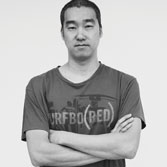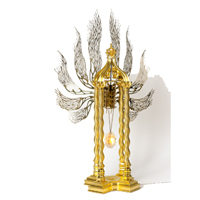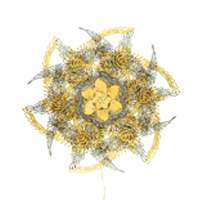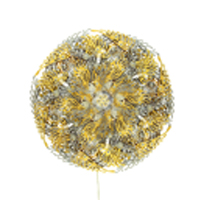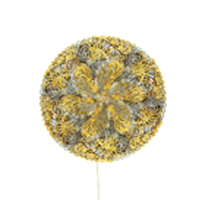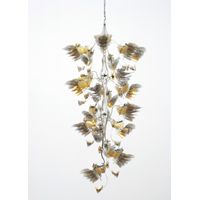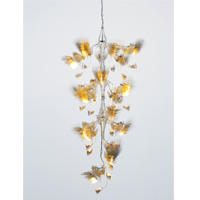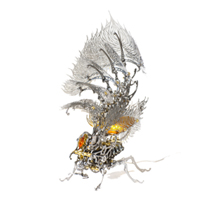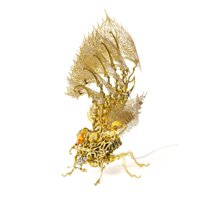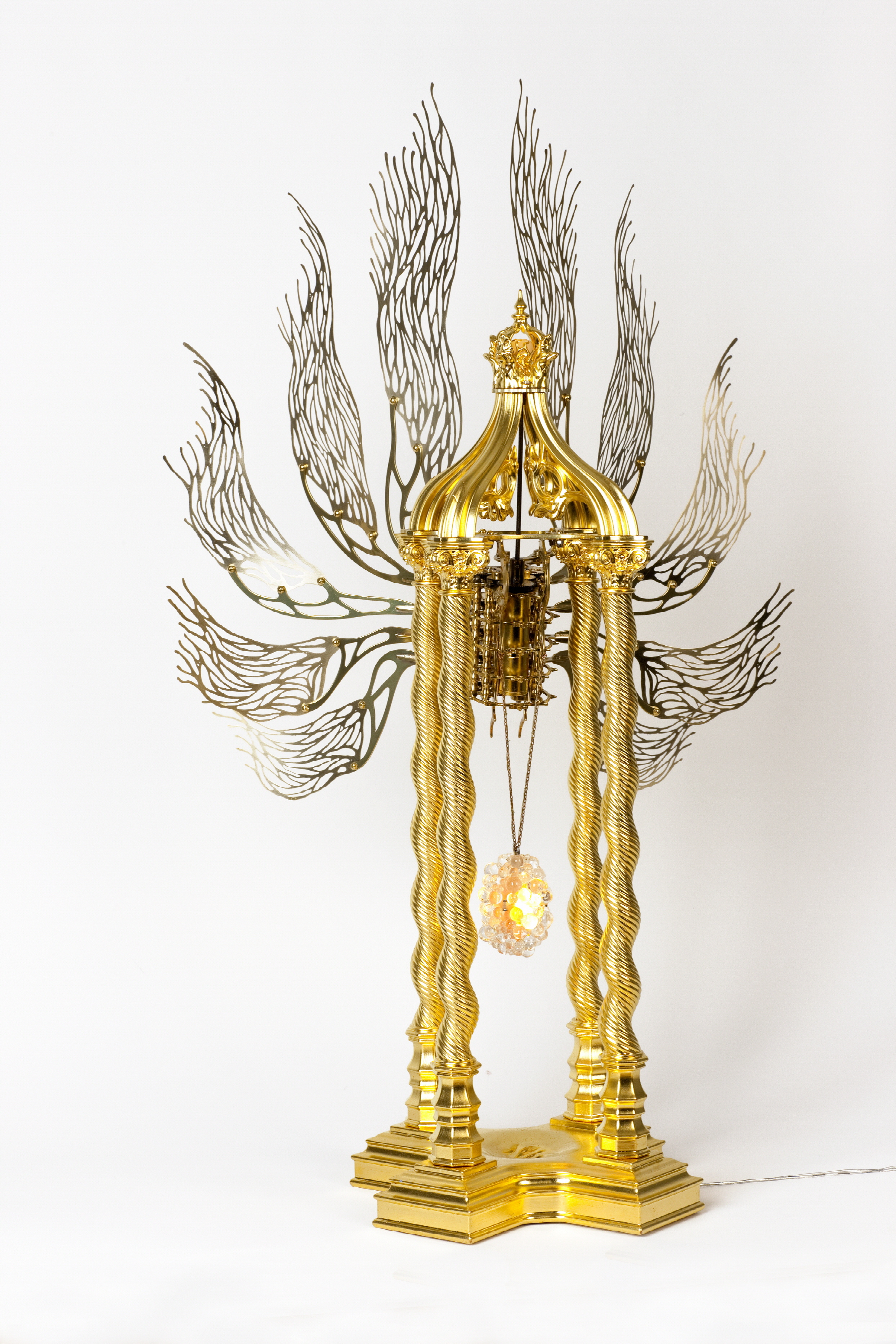
Temple Lamp , 2013
Metallic Material, Machinery, 24K Gold Leaf, Glass, Resin, Electronic Device(CPU Board, Motor, LED), 36x50x82cm
THE MECHANICAL LUMINOUS CREATURE DANCING ON MYTHS - Exploring the human primal desire with U-Ram's mobile sculpture
Humans have imagined the future over and over in science fiction stories. It takes shape in a post-apocalyptic world, an alien attack, a nuclear explosion, or the mutation of a virus. We march into a new century yet to find ourselves swamped in end-of-the-world discourses; in response, we develop high technology as human history has never before seen. Still, the hope of the future seems to remain drifting in a vast barren territory. We may rely on the green technology to masquerade this endless infertility, but we know it’s there. In film or in literature, fiction reflects not only our imagination; it also reveals our anxiety, insecurity, and the cruel reality in which we are living.
The Enigmatic Creature from Future Technologies
Then you walk into the dim room, and you find unknown creatures floating quietly in the air, glowing on and off as if they are breathing. Their figures resemble those of fish or birds, glistening metallic lights. Are they surveillance planes in the dark which, with no pilot on board, evolve into futuristic mechanical organisms? Or perhaps they are metallic flowers swimming forward, one after another. The flowers are gigantic matrixes in the shape of a black widow spider with encrypted petals, whose repeated movements reflect the shivers of light and shade. The flowers, with their petals folding and unfolding, swallow anything near and afar. The spinning and shining pistils are so protruding in the heart of the flowers that their reproductive images cannot be mistaken. Somehow, the pistils also bring to mind the laser beams from all those star wars on screen…
This is what came to mind at Urbanus, the new exhibition by South Korean artist Choe U-Ram in the Mori Art Museum, Japan, in 2006. This exhibition expresses Choe’s imagination of the city, through mechanically powered sculptures but in the form of organism. The title is inspired by Choe’s experience overlooking the city on skyscrapers in Tokyo. Due to the unique location of the Museum, and due to the belief that artwork needs to respond to the space where it is on display, Choe creates for Tokyo a set of urban monsters hidden on top of the city’s skyscrapers. Male mechanical monsters float around absorbing electronic streams and lights so they can feed the females in the nest and together they will breed. The background of their residence or, one should say, their site of exhibition is the metropolitan landscape packed with crowds and electric lights, outside the huge windows of the Museum.
And there you will see newborn mechanical floaters hanged next to the female ones. The grown-ups and the newborns are placed within the same room to give a clear idea of the family tree of those urban floating subjects. The audience finds as if they are not at an exhibition of contemporary art; rather, they travel through time and space to the museum of nature in the future. Indeed, Choe is one key member in mobile sculpture in South Korea today. He uses metal, motor, and LED lights to make fantastic and enigmatic mechanical organisms. Not only does he create lively figures and movements, he also names all of them and gives each a life story. Choe would employ the Latin language to name his works to intensify the impression of their presence; he also expects the audience to explore the meanings and imaginations of his works through those old, unfamiliar Latin names. According to Choe’s own introduction to this exhibition, a scientific study provided by the United Research of Anima Machine (URAM),a fictional laboratory, all the mechanical creatures are newfound organisms from prehistoric times or outer space, allowing us to discover the secrets of the universe. The introduction—and the study—are, of course, a part of Choe’s artwork, that is, storytelling.
Compressing the Active Force of the Universe into Mechanical Movement
Opertus Lunula Umbra, Choe’s submission to Liverpool Biennial in 2008, is a work of imagination reflecting on marine cities. According to a report by URAM, the fictional research lab made up by Choe himself, the moon has tremendous impacts on the human being, so much so that it confuses one’s faculty of distinguishing the real and the unreal. According to the findings based on the observation of a Liverpool kid by the waterfront, the report continues, because of the moonlight reflected on the water, it is a common syndrome for people of the marine city to have collective hallucinations. The creatures “on display” is a gigantic chrysalis in the shape of the crescent moon, and they are composed of all the ships, boats, radars, and marine equipment drown under the ocean over the past centuries because of the moon.
Just like the tide and the moon, the line of brown tentacles on the chrysalis appears to wave, one after another, in correspondence with the breathing rhythm of the chrysalis. The chrysalis is itself the new moon and the tide combined. In that tranquil motion, one feels Choe’s attempt to understand the active force of the universe through his sculpture in all the tiny mechanical movements of his works. Just like the creatures at Urbanus in Tokyo, the chrysalis of lighting bugs in Liverpool quietly absorbs the natural energy that either is ignored or drives us paranoid.
To Choe, the definition of life is uncertain. Once the machine begins to move there is the birth of a life, its movement in line with the natural flow and itself containing a life force from within. This is how his works have their own story and speak to their audience of their existence in the society. Born in Seoul, 1970, one sees how Choe’s family has deep influence in his art. Choe’s grandfather was a mechanical engineer, and both his parents were artists; this upbringing at home seems reasonable that Choe would one day pick up mechanical sculpture. Growing up in the prestigious Gangnam area, Choe saw the rise of skyscrapers so relentlessly that he imagined the building to turn alive and begin to move one day. To the generations so saturated in science fiction movies and robot animations, it is only natural to think of the machine as if they are organisms with consciousness. And it is no surprise that we find resemblance of creatures from the Alien movie or any Miyazaki Hayao anime in Choe’s works.
Sexual Desires and the Mechanical Flesh
The opposition of technology and nature is the core of Choe’s storytelling. In Choe’s work, the series of movement of delicate metal parts and sculptures mimic organisms, simulate motions like breathing, and express the form of life. The documentaries of animals as well as programs from TV channels like Animal Planet give Choe inspirations on evolution and movement, allowing him to apply ideas of nature to mechanical structures. He is also interested in conveying the desires and oppressions of survival through creating a balanced and circulated system of energy that signifies the world. Take his UnaLumino for example. This 2008 piece is a beehive-shaped sculpture of 5 meters tall, with no obvious skeleton or interior structure of the sort for support. It is composed of over one thousand white yet translucent lights in the shape offlower; together they look like a community of message and energy exchange. Each of the flowers moves on its own, illuminating when blooming and dimming as it folds. Here, the flower’s cycle of life is transformed into a series of continued movements.
Yet, Una Lumino does not have the division of labor like the bees or ants despite its shape. The flower-shaped lights are more like parasites, clinging and connected to an unknown central nervous system; they act collectively within the system, and they respond to what this system senses. This artwork gives the impression of an organism surviving an explosive event, and what is left of the body is to breathe and react, that is, merely to survive on instinct. One also sees Choe’s idea of totality in Una Lumino: a single cup of light is but a “part”, a fragment of the whole; it is only meaningful as a “life” when all the “parts” gather as a community of active collective. All the “parts” fall in their right place in the harmony of this structure, with no beginning or end, no climax or accident. The eternal stability by its circulating, inherent force becomes the primary pattern of coordination and survival for the collective in Una Lumino.
Even so, the living mechanical sculpture may be confronted with discomforting and stealthy menaces. The aura of delay and silence surrounding Una Lumino brings to mind the mechanical installations by German artist Rebecca Horn. In her works, in those motor-engineered, flapping or swaying feathers and butterflies, there is always an ambiguous appeal. They captivate and resist the audience simultaneously, blocking our involvement, fascinating us yet sui generis. Rebecca Horn communicates a peculiar sense of flesh and sexuality through the tardy movement of the cold machine. Choe’s works are similar to Horn’s, both swinging between pleasure and danger.
The Enigmatic Alchemy of Metamorphosis
A flesh, soft, composed of firm leaves like scales or wings that move like tidal waves. The flesh is bizarre, mysterious. When all the volumes, one piling upon another, are in serial and rhythmic movements, they bring forth a visual quality of variability and enigma. Choe’s alchemy of metamorphosis creates the obscurity and mystery of mechanical organisms by his play of the complex relations and movements between forms. In the bizarre space of their movements, the tremble of internal correspondence seems within reach. Choe’s creative works can be divided into two stages, the first concentrated on the making of creatures of peculiar forms. He would explore his art in the manner of natural sciences and in the name of URAM, and most of his works in this period were on the simulation of different forms and movements. Since 2010, Choe turned to myths and became more interested in symbols and social implications. He also began to name his works in Sanskrit instead of Latin.
Cakra-2552-A is one such artwork from the new stage. Inspired from Buddhist Mandela, the work’s name “Cakra” comes from the Sanskrit language with the meaning of “wheel” or “turning”. It is an installation with the wheel-like outlook composed of arc-shaped pieces of turning metal and gears, ostensibly an exposed timepiece without the dial at first glance. As all the inner structure is disclosed, the secret of time seems to be unraveled, and we are invited to a dance in a circle with time. Cakra-2552-Awhirls quietly and peacefully, with such a steady pace in motion, as if it is itself an all-encompassing universe in perfect order. On the other hand there is Ouroboros, Choe’s 2013 creation. It is inspired by myths available in both the East and the West, where a serpent eats its own tail. In the myth, the serpent’s mouth symbolizes birth and its tail death; for Ouroboros, both reproduction and destruction, or the positive force and the negative one, are posited in the same body to convey the idea of eternal circle. It also continues Choe’s creative interest in giving life to the machines. Both Cakra-2552-A and Ouroboros are Choe’s interpretation of the cosmic movement and the progress of time; they are also the visual creation of Choe’s perception of the universal force.
From Prophecy to Return to the Living Fossil of the Ancient Time
The turn to myths allows Choe’s art to be more than prophetic; it also becomes antique, with fossil-like qualities. The following two pieces of Choe’s work need to be understood from his ideas of myth so we can approach their full meaning. Arbor Deus materializes the mythical tree of gods to tell the prophetic tale of global warming. In the prehistoric time, humans lived peacefully with the gods as well as all the creatures; then the earth moves away from the sun and enters the ice age. The humans walked into the last forest and prayed for the protection of the gods of trees, of birds, and of steel. The god of steel placed his head into the body of the tree and made it hard as steel; the god of birds put her uterus into the steel tree, and the branches turned into steel wings. All the three gods sacrificed themselves to save the world. Before they died, the three gods told the humans that the tree with steel wings would continue to grow; it would grow into an enormous forest in a hundred years and flap its wings to bring the earth close to the sun. However, the humans were cautioned that the tree should not grow too fast, in case the distance between the earth and the sun would be out of control that destruction might come again. But the humans could not bear the cold. They craved warmth so much, and they forced the steel-winged tree to grow so fast that the tree covered the entire earth in tens of days. The humans celebrated, feasted, and spreed. In no time, however, they found the heat to be unbearable that it was impossible to stay outside. The humans began to chop down the trees and melt the wings, trying to amend the climate and make it cordial. But it was too late after all. All measures of remedy were in vain, and human beings were exterminated in the incredible heat along with their civilizations. The tree with steel wings continued to grow, and the earth kept rushing toward the sun till it eventually melted.
The other piece Custos Cavum refers to a 10th-century Indian sculpture commonly known as “dance of Shiva”. Originally, “dance of Shiva” was to search for the ultimate and absolute meaning of birth, death, and reincarnation. Choe keeps only the metaphors of the process of creation, protection, and destruction, and invents a myth of the cave guardian. He bases the image of the guardian on Antarctic seal and its habit hunting in ice caverns. In his myth, the guardian safeguards the cavern and gnaws its entrance to prevent the cavern from being blocked because the cavern is actually a hole, a tunnel to the other world. When one end of the tunnel is opened, the guardian will produce a spore that flows elsewhere to become the burrower and the guardian of another cavern. But little by little humans forget about the other world, and one after another the guardians begin to die. The hole to the tunnel, the sign of communication, disappears along with the bygone memory. The guardian represents coexistence in harmony; the very being of the guardian signifies the cycle and equilibrium of the universe. In contrast, Choe’s Custos Cavum looks dormant, and its skull gives the impression of a specimen.
The Decayed &Disorder under the Surface of Extravagance
The myth from the prehistoric time remains a powerful reference and contrast in the contemporary technological and social context. After Choe established international reputation, he began to rethink his Korean identity and relentlessly criticize conventional social values since 2012. Unlike the fantasized mechanical organisms in Choe’s earlier works, Pavilion and Merry-go-round turn to exquisite images, a theme more familiar to the audience. Take Merry-go-round for instance. On the stand, the miniature carousel does not appear to impress us at first glance; but, the trick is, the music soon begins to rush, and the carousel spins faster and faster, till everything becomes an indistinct and horrifying sight. Choe considers this work a reflection of the values of his fellow Koreans in the contemporary time. To him, people in South Korea appear to spend excessive energies for money, status, and power, just as the ever-turning merry-go-round, while the real value of life has been long exhausted. Pavilion also questions the frenzied pursuit for fame and fortune. In this piece, Choe makes a dazzling, exquisite altar to represent the illusion of fetishism; under the stunning golden ball is a floating black plastic bag. The bag is the fallen angel in the world of overflowed wealth, and the light reflected on the ceiling seems like a perplexing web, projecting enormous disquieting menace.
Golden decadence or madness, mythic beasts or urban parasites, Choe’s mechanical sculpture accomplishes in movement the uncanny beauty and the urgency of death. Those mechanical organisms emanate dim lights like jellyfish floating deep in the sea, or like the unexpected flash of starlight in the pitch-black universe. There are rotten smell and furious mutation; quiet motions are, in effect, shady menace. This is but contemporary angst, human being’s innermost primal fear confronting chaos and absolute disorder.
Chow Ling-chi
more
Dream of the Extended Automata: U-Ram Choe's Mechanical Life Forms
Consequently, each part contains in itself springs whose forces are proportioned to its needs. Let us consider the details of these springs of the human machine. Their actions cause all natural, automatic, vital, and animal movements. Does the body not leap back mechanically in terror when one comes upon an unexpected precipice? And do the eyelids not close automatically at the threat of a blow? ... Do the lungs not automatically work continually like bellows?
- La Mettrie, L'Homme Machine, 1748(1)
Correspondence of Mechanical Aesthetics and Natural Form
Surrounding a central axis rotating counter-clockwise, 6 cylinders simultaneously rotate in a clockwise direction. Each cylinder is engaged with metal plates crafted in certain patterns, which move up and down from 90 to 120 degree angles. There is a total of 5 layers, each with 6 decorative plates, in the shape of wings or clouds. One metal plate on a lower layer is meshed with two plates on an upper layer. The forms of the metal plates vary depending on the layer, and alternate between brass and stainless steel, in terms of material. As they move from one direction to the other, the metal leaves gather towards the center, and then spread out, infinitely repeating the movement of opening like a flower in full bloom and then closing, in correspondence to the title, which means "wheel" in Sanskrit.
This is a description of Gold Cakra Lamp (2013), which was shown in the Lamp Shop exhibition at Gallery Hyundai. This lengthy and detailed explanation is to demonstrate that even this work, which is one of the simplest works made by U-Ram Choe, is invested with a significant level of technical exquisiteness and formal beauty, both structurally and aesthetically. It is this character, i.e. the formative beauty of the structure and details, and the delicate grace of movement, that differentiate Choe's moving sculptures from other kinetic sculptures.
The outstanding decorative beauty resembling master craftsmanship is the primary element that captivates viewers. The movement part of Gold Insecta Lamp (2013), also entered in the same exhibition, reminds viewers of peacock feathers or flame-shape ornaments on a traditional gold crown, and the gently moving shades on the Gorgonian Chandelier(2013) are crafted in elaborate patterns resembling rocking waves or swaying seaweed. The hand-made precision applies to all areas including selection of material, manufacturing, engineering and production. For example, the decorative leaves of the Gorgonian Lamp (2013) were made by etching stainless steel plates, smoking them to kill the glaze, and sanding them to give an antique look. The 29 pairs of wings on the Opertus Lunula Umbra (2008), nowinstalled in the National Museum of Modern and Contemporary Arts (MMCA), Seoul, were produced by making the prototypes with ABS resin through Computer Numerical Control (CNC) processing, and attaching wood sheets of various patterns on them, of which the best ones were cast with silicone. Then the final models were made with FRP plastic and colored. It is not only the ostensible appearance of the works that requires many levels of intervention of craftsmanship, making them worthy of the term "labor-intensive."Since size and shape, positions of motors and gears differ in every work, each time a new work is planned, it must be designed anew, down to the smallest parts, such as bolts, nuts and bearings. Even in the case of simple works like the Cakra Lamp, more than 150 parts in 20~30 categories are required, and in the case of large-scale works such as the Opertus, more than 5,000 parts belonging to some 200 categories must be newly produced. Therefore, it is no exaggeration to say the formal level of completion Choe achieves in his visual art is a result of the master craftsmanship in the design and production process, and the consequent formative beauty.
Having said this, the fact that the decorative patterns in Choe's recent works resemble Art Nouveau is an analogy significant in many ways. The decorative craft described earlier would be the most obvious, but a more fundamental common point is that the origins from which the forms were drawn are similar. Art Nouveau, famous for its vine-shaped decorations, was characterized by its interest in organic structures inspired by natural forms, and achieved unity of material, structure and expression through the abstraction of the slender curves of plants by using metal, which was easy to form. The mutually contradictory elements of the mechanical aesthetics of metal and the dynamic nature of organisms coexist in U-Ram Choe's works as well. First of all, the artist's pseudo life forms, known as "Anima Machines," mostly get their motives from actual organisms in terms of form and function. The Gorgonian Chandelier takes after the movement of fan coral swaying in the water, Una Lumino (2008) got its idea from the way barnacles open, and the source of inspiration for Jet Hiatus was a shark's teeth digging into a school of sardines. The more decisive factor, however, is that the resemblance between the two go beyond formal similarity, and reach structural and functional alikeness. One of the hidden contributions of Art Nouveau, which is often mistaken as just decorative art, is functional consistence of the form, in which the metallic structures made for functional purposes also achieve aesthetic objectives at the same time. E. Viollet le Duc's cast iron supports and Victor Horta's roof trusses are not only structures, butalso decorations that bring out the best of the sensuous curves of organisms. In Choe's works also, even the practical parts used for movement do not lose their formative beauty. Such a tendency is present throughout all his work, but the early work Lumina Virgo (2002), which is the origin of the Lamp Shop exhibition, seems to act as a turning point in terms of unity between decoration and function. In this small lamp, which can be turned on and off by touching the feelers, many large and small gears are activated to open and close the wings. These parts not only function as toothed wheels, but also form decorations in the shape of a hand, based on Michelangelo's The Creation.(2) Rationality, in which form and function coincide, is an important virtue in mechanical aesthetics, and can be applied just the same in the movement of Choe's works.
Animal Machines and Mechanical Life Forms
In an interview, U-Ram Choe referred to his work as "a story of a machine gaining life with the element of movement and the theme of machine."(3) Here, the characteristic of movement is the main aspect that makes his works different from other kinetic sculptures,which emphasize concept or interaction with spectators. The way Choe's machines work is inspired by the movement of living creatures. An interesting point is that he tries to make them as natural as possible while using the least elements. In Gold Insecta Lamp the five moving wings are all connected to a single axis. The major axis, which is an extension of the hind legs of the grasshopper, is controlled by a single motor, and each wing opens and closes in sequence according to the movement of gears. The reason the movements of the wings seem natural is because they do not open and close at once, but move in turn, with a timelapse. When the bottom wing is at its lowest point, the other wings are already on their way up. The core and charm of these movements is that they are not controlled digitally, but through an analog method based on the simplest principles of the rotatingaxis. By using the principle that the movement radius is larger when it is close to the rotation center, and smaller when it is far, each wing was given a difference in the range of motion. Such attitude of preferring simple and effective structures can be seen throughout his working process, with no exception in the movement of birds' wings―one of the artist's favorite motives. The two wings of Arbor Deus Pennatus(2011) are also controlled by a single motor. The gears connected to the motor rotate along with other engaged gears, and the two axes connected to these gears move in different rhythms, thereby creating a natural and elegant movement.
The functionalist aesthetics, combining beauty and efficiency, is identical to the physiological principles that constitute the bodies of animals. Construction to achieve the most efficient function results in beauty. The analogy of machines and animals is a fundamental aspect penetrating all of Choe's works. His motivation for obtaining subject matter is animals or plants, and he designs his detailed structures and movements from the skeletons or movements of actual life forms. Furthermore, his principle of motion that pursues economic efficiency, and his final goal of creating "life as it could be"(4) are all based on the combination of machine and living thing. The comparison between animals and machines has a long history, tracing back to the age of enlightenment. Descartes claimed that animals were machines made only with matter, and saw humans also as mechanisms that moved according to mechanical arrangement, just as clocks or automated dolls move according to the placement of counterweights or gears, besides having souls.(5) Such a doctrine of the human machine was compiled by La Mettrie, who defined the human body as "a machine which winds its own springs," and "the living image of perpetual movement."(6)To the materialist La Mettrie, who thought the soul was also a function of the brain, a thinking muscle, movement of the human was merely mechanical, and something maintained through the energy transported by blood, circulated by the heart―a certain hydraulic device.(7) Theperception of "an automated machine with its own principle of movement" sees humans as a kind of automatic dolls. Such discussions were later demonstrated in reality with the support of precision mechanical engineering and the growing interest in anatomy. Examples include Jacques de Vaucanson's mechanical duck, which was famous for eating and excreting, and Jaquet-Droz's writing automaton, which is still functional. These examples belong to the genealogical roots of U-Ram Choe's automata in terms of both philosophy and engineering.
Between Automatic Doll and Artificial Life
There are complex reasons for considering Choe's mechanical life forms as reversions of the 18th century automata. First, theyare both elaborate mechanical devices with carefully designed internal structures, and are similar in the way they link anatomical structure and function with the machine. While de Vaucanson imitated humans' breathing organs when he made the Flute Player,giving it levers and valves to move its lungs, airway, lips and tongue, U-Ram Choe mechanically embodied a bird's flapping wings, based on the dual structure of an actual bird skeleton, consisting of the radius and ulna, in Arbor Deus Pennatus. The more fundamental similarity, however, lies in the motive or desire to make the mechanical device. Choe's works are often discussed in association with the fusion of art and science, artificial life, robotics or cyber art, but in fact his works are in principle true to the basics of mechanical dynamics, which consist of motors, gears, and dynamic components, and are only assisted by a CPU board to control the pattern and time of the movement. His fascination with machines is something Choe has confessed in many interviews. The automative dolls of the 18th century also began from the dreams of inventors, who wanted to make a machine that was more than a machine, by applying the highest level of precision and technology. (It is no coincidence that many works by U-RamChoe remind us of elaborate clockwork.) Moreover, the "moving" automata share the characteristic of ultimately trying to imitate or create life. This is because movement is the inborn nature of life, and whether something can move on its own or not becomes a standard of determining life. The reason Choe's clearly lifeless machines with metallic bodies feel like they are in fact alive is due to lightand natural movement, which are the symbols of life.
From the perspective of life, it is quite suggestive that there are many "breathing machines" among U-Ram Choe's mechanical life forms. The thrilling dance of the Opertus Lunala Umbra, which is the largest and the most visually overwhelming among his works, begins with the ribs or shells of a crustacean moving up and down in gigantic breaths. The secret of the popularity of Custos Cavum (2011), which was the greatest hit in Choe's 2012 solo show at Gallery Hyundai, was that it resembled a sea lion breathing in a realistic fashion. The core mechanism that makespeople believe the machine is alive, is the difference between the rapid inhaling and slow exhaling motions. A lifeless being breathing is a sign that it has become a living thing, and it is an act of bestowing the status of god to the maker. This is because the ontological ambition indwelling in all automated dolls is in fact a Promethean rebellion, an overtaking of the privilege of creating life. In that sense, the artist's strategy is to give a more solid status to his "life as it could be," by using the authority of science in his pseudo-scientific Latin names andecological reports(imaginary birth legends), which often accompany his sculptures.
Ultimately, U-Ram Choe's mechanical life forms transcend the dream of the automated doll, which attempts to imitate nature. His "experiment to study the relation between a newly born species (machine) and human society through the way humans' creations group and multiply on their own" (quote by artist) transcends "life as we know it" and extends to another artificial life that moves according to its own logic and free will. They not only imitate existing organisms, but mix up the borders of categories by mutually combining heterogeneous elements. The movement of a jet engine and a shark's teeth are fused to breed a machine with an animal (Jet Hiatus), and an animal-plant hybrid is made by crossing a barnacle and a flower (Una Lumino). Furthermore, these quasi life forms make up an ecosystem where adult and larva, or male and female coexist (Urbanus series (2006)),represent interacting imaginary mechanical life forms in a community (Una Lumino), and advance from individual beings towards forming a part of nature or the universe. (Kalpa (2010), a cosmos series that retraces the origin of life, is at the end of that path.) What is important here is not how much these virtual life forms satisfy the scientific definition of artificial life, but how much they contribute to reconsidering and extending the concept of life on the horizon of imagination. This is the point at which U-Ram Choe's work functions as visual art, and the reason why his mechanical life forms serve as a contact point for remediation(8)with the 18th century's dream of the human automata, and the 21st century's pursuit of artificial life.
------------------------------------------------------------------------
(1) Gaby Wood, Edison's Eve: A Magical History of the Quest for Mechanical Life (New York: Anchor Books, 2003), p. 14.
(2) Though with a different emphasis, in the introduction to the 2006 exhibition at Mori Museum of Art, Kim Sunhee also noted Lumina Virgoas a work representing U-Ram Choe's entire body of work. Kim Sunhee, "Alien Life Forms: The Art of Choe U-Ram," City Energy-MAM PROJECT 004, Mori Museum of Art, 2006, p. 31.
(3) Interview with Aliceon on January 18, 2009.
(4) The term of Christopher Langton, who established the concept of artificial life. Langton expanded the concept of life from "life as we know it" to "life as it could be." Christopher Langton, "Artificial Life," Artificial life: the proceedings of an interdisciplinary workshop on the synthesis and simulation of living systems held September, 1987 in Los Alamos, New Mexico, Volume 6, Santa Fe Institute studies in the sciences of complexity (Addison-Wesley, 1989).
(5) Gaby Wood, Edison's Eve: A Magical History of the Quest for Mechanical Life (New York: Anchor Books, 2003), p. 10.
(6) Julian Offroy de La Mattrie, Man a machine, tr. Gertrude Carman Bussey (The Open Court Publishing Co., 1912), p. 93.
(7) Young Ran Jo, "La Mettrie's Mind-Body Theory in L'Homme Machine and Life Sciences in the Eighteenth Century," Korean Journal of the History of Science, Vol. 13, no. 2, 1991, p. 148.
(8) Used by Jay David Bolter and Richard Grusin, the term refers to how new media uses existing media or other contemporary media for reorganization. Jay David Bolter and Richard Grusin, Remediation: Understanding New Media, MIT Press, 2000, pp. 3-15.
Hye Jin Mun (Art Theory)
more






